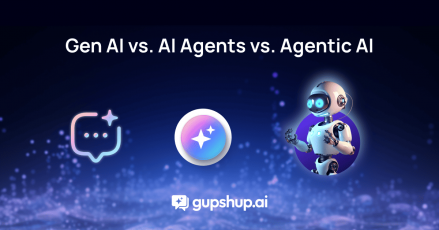Are Conversational Chatbots Better Than Lead Forms?

The digital transformation of businesses has been remarkable, especially in how they engage with customers. Customers nowadays search for more personalized interactions rather than static web forms. Hence the growing preference for AI conversational chatbots.
As chatbot investments rise, about a quarter of organizations will use them as a primary channel for customer service and support by 2027.
Unlike static lead forms, an AI chatbot engages with potential clients in real time, mimicking human conversation and providing instant responses. This dynamic exchange can distinguish between a lead lost to impatience and one that gets instant attention and moves a step closer to being a customer.
Now the question is, are AI conversational chatbots better than static lead forms?
Let’s find out.
Changing Communication Habits: Customers Prefer to Chat More!
In an age dominated by digital interactions, the way people communicate is evolving rapidly. As Smart Insights, the average internet user dedicates nearly 2 hours 23 minutes daily to social media platforms, comprising over one-third of their total online time.
WhatsApp has around 2.7 billion active users globally. The users engage in over 2 billion minutes of audio calls and exchange around 100 billion individual messages daily. On average, each user dedicates 33.5 minutes per day to the app, engaging in a variety of activities including voice calls, voice notes, and instant messaging.
So, with this substantial number of users communicating daily through online media, it’s no surprise that AI chatbots are gaining precedence!
Web Forms – Why Do They Not Work Anymore?
Static forms on websites can be a stutter in the smooth conversation between a prospect and a brand. These forms stay the same — no replying, no adapting — which can bore people or leave them puzzled. Often, they demand too much info, and that’s when folks bail.
This isn’t just annoying for the user; it’s a miss for businesses. It’s like never getting to say ‘hello’ because your visitor just walked out the door too soon. That’s a lost connection, a lost lead.
Website visitors nowadays expect a conversation, not a questionnaire. As for static web forms, their one-size-fits-all approach falls short. Each question is set in stone and cannot be changed, which means sometimes your visitors might leave your site because their queries were unanswered.
The result? More people give up, and even more, get their info wrong. In fact, a latest study from ProFaceOff reveals 81% of website visitors abandon online forms, generating fewer leads.
Can Conversational Chatbots Fill the Gap?

AI chatbots are smart digital assistants, that engage customers on websites to bridge the gap between traditional web forms and personalized interactions. By leveraging chatbots on websites, brands can offer users a familiar conversational interface, enabling quicker and more personalized interactions.
What makes it more efficient is that these chatbots can then seamlessly transition users to WhatsApp, tapping into its popularity and convenience for ongoing conversations and transactions. Chatbots integrated with WhatsApp API can deliver tailored responses based on user queries, enhancing the user experience. Additionally, these AI chatbots can handle routine inquiries and transactions efficiently, freeing up human agents for more complex interactions, and thereby enhancing scalability and responsiveness.
This approach enhances user experience and provides brands with an “always available” channel to engage with customers, leading to improved customer satisfaction and higher conversion rates.
But what makes AI chatbots for business a game changer?
These bots are powered by artificial intelligence. Machine learning lets them understand customer queries, and natural language processing enables human-like responses. By guiding users and asking questions, AI chatbots help businesses figure out who might buy something and who’s just looking around.
AI Chatbots vs. Lead Forms

How Do AI Chatbots Boost Conversion Rates?
1. Boosting Conversions with Chatbots in PPC Ads
Replacing traditional landing pages with chatbots is a smart move to boost your conversion rates. When visitors are greeted with a chat, they feel more connected to your brand, which increases trust and conversions.
Wondering how to make it work? Simple! Instead of landing on a static page, make your customers click on your ads and direct them straight to a conversational chatbot. This seamless interaction can double or even triple your conversion rates, waving goodbye to boring web forms. Plus, you can integrate your chatbots with Google Ads and Facebook Ads for maximum impact.
2. Capturing Leads with Chatbot-Powered Lead Magnets
Lead magnets, like free resources, are excellent for gathering customer details. But with conversational chatbots, you can effortlessly capture email addresses in exchange for valuable resources. Whether it’s a white paper, newsletter, or blog, chatbots make the exchange smooth.
Email remains a powerful marketing tool, with various examples showing its effectiveness for customer acquisition and retention. Collecting emails through AI chatbots can be a game changer for lead generation and qualification, helping you nurture relationships and boost conversions.
3. Enhancing Conversations with Engaging Media
Want to spice up your AI chatbot conversations? Add visuals like GIFs and images!
Visuals have a huge impact and can make your chats more engaging. By integrating media blocks into your chatbot, you can easily include graphics and GIFs to captivate your audience. Whether you prefer pre-built templates or custom designs, chatbots can make your conversations pop and drive conversions.
4. Being Proactive in Conversations
Chatbots excel at engaging customers in real time. With triggers like scroll depth, inactivity detection, and location targeting, you can start conversations with visitors at the right moment on any platform like WhatsApp, messenger, etc. Personalized messages, product recommendations, and discounts can all be automated to guide visitors through the buyer’s journey. By being proactive, chatbots can turn casual browsers into loyal customers, ultimately boosting your conversion rates.
So, Can AI Conversational Chatbots Replace Forms?

While AI chatbots can’t completely take over all the jobs that forms do just yet, they can handle many of them, especially the simple ones. It can ask customers straightforward questions and get their answers, kind of like filling out a form. These chatbots follow a set script, so they’re great for basic interactions that don’t change much.
Conversational chatbots come in when things get more complicated, or people want to chat in their own words. They can guide users through complex processes, provide instant feedback, and even learn from interactions to improve over time.
The surge in popularity, usage, and reach of AI chatbots in business suggests a path toward a reality where conversational AI can easily handle even the most complex form-based transactions. They not only replicate but could enhance the form-filling experience by adapting to unique user responses and maintaining context over a conversation.
Despite this potential, specific use cases may still require the precision and structure of traditional forms, such as legal documentation and detailed applications. As chatbot technology continues to evolve, the balance may shift, but for now, the utility of AI chatbots over lead forms depends on the specific requirements of the business.
How to Implement a Conversational Chatbot?
1. Select a chatbot platform
When choosing a chatbot platform, look for one that is easy to use and set up. It should offer customization options to fit your specific needs. Gupshup offers seamless integration with various messaging channels and provides a user-friendly interface that requires no coding.
2. Design engaging conversations
Create conversations that feel natural and helpful. Keep the chatbot’s language friendly and approachable. Use clear and concise prompts that guide users through the flow, ensuring their questions can be answered efficiently.
Gupshup’s conversational ai platform allows for a seamless conversational flow in AI chatbots.
3. Monitor and optimize chatbot performance
After your chatbot goes live, watch how users interact with it. Use the data to make improvements. Gupshup offers tools that help analyze chat transcripts and user satisfaction, making it easier to optimize your chatbot’s performance.
Conclusion
AI conversational chatbots offer several advantages over traditional lead forms. They provide a more personalized and engaging interaction with users, increasing conversion rates and improving customer experiences. Chatbots streamline the data collection process by personalizing conversations, making it easier for users to provide information. Plus, they’re affordable and can handle a lot of interactions without needing extra manual effort, making them great for generating leads.
Get the most of these benefits with Gupshup’s conversational AI platform that helps businesses create seamless conversational experiences across the customer journey. With features like virtual assistants, bot studio, and more, Gupshup empowers enterprises to build engaging and personalized connections and drive results throughout the customer lifecycle.
Talk to a Gupshup expert to learn more!





